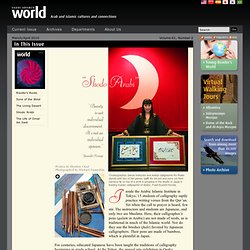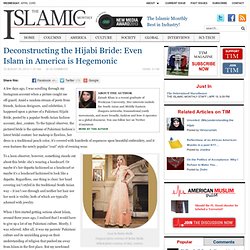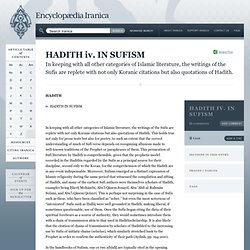

Shodo ‘Arabi. Nside the Arabic Islamic Institute in Tokyo, 15 students of calligraphy raptly practice writing verses from the Qur’an.

Yet when the call to prayer is heard, few stir. The instructors and students are Japanese, and only two are Muslims. Here, their calligrapher’s pens (qalam in Arabic) are not made of reeds, as is traditional in much of the Islamic world. Nor do they use the brushes (fude) favored by Japanese calligraphers. Their pens are made of bamboo, which is plentiful in Japan.
For centuries, educated Japanese have been taught the traditions of calligraphy beginning in grade school. Yukari Takahashi, who owns an elegant Tokyo nightclub, holds up a sheet of Japanese rice paper with embossed floral patterns framing immaculate calligraphy. Admiration runs in the other direction, too: In 2007, at the most recent international calligraphy competition of the Istanbul-based Research Center for Islamic History, Art and Culture (ircica), four Japanese entrants won prizes. The Sufi Frida Kahlo. Samina Ali: You are a sculptor, video artist and a photographer.

I can see your various talents influencing your photographs, which look like haunting paintings. In fact, I’ve heard you described as the Sufi Frida Kahlo. What is the inspiration behind your work? I'm glad to be considered a Sufi Frida Kahlo! Frida was a great woman and artist, and although life was cruel she was able to transform her suffering into art of the highest quality. My moods are expressed in my work as faces, color, and emotions, where the body is no longer a prison of the soul, but rather like a temple to house and augment the Divine. The slideshow that’s part of our exhibition is showing images of mystical figures from Islamic Africa. Deconstructing the Hijabi Bride: Even Islam in America is Hegemonic. ABOUT THE AUTHORZainab Khan is a recent graduate of Wesleyan University.

Her interests include the South Asian and Middle Eastern diaspora networks, transnational youth movements, and more broadly, fashion and how it operates as a global discourse. You can follow her on Twitter @zaynmanMORE BY THIS AUTHOR A few days ago, I was scrolling through my Instagram account when a picture caught me off-guard. Amid a random stream of posts from friends, fashion designers, and celebrities, I happened upon a picture of a Pakistani Hijabi Bride, posted by a popular South Asian fashion account, desi_couture. To the typical observer, the pictured bride is the epitome of Pakistani fashion’s latest bridal couture: her makeup is flawless, her dress is a traditional peach color, it’s covered with hundreds of sequences upon beautiful embroidery, and it even features the newly popular “coat” style of evening wear.
To a keen observer, however, something stands out about this bride: she’s wearing a headscarf. HADITH iv. IN SUFISM. Iv.

HADITH IN SUFISM In keeping with all other categories of Islamic literature, the writings of the Sufis are replete with not only Koranic citations but also quotations of Hadith. This holds true not only for prose texts but also for poetry, to such an extent that the correct understanding of much of Sufi verse depends on recognizing allusions made to well-known traditions of the Prophet or paraphrases of them. Ziad El-Hady: Prophetic Attitude to Disability. Not a great deal of information can be found in the life of the Prophet or in the Qur'an regarding the issue of disability.

But like many other issues with the Islamic tradition, a lot can be drawn from a single prophetic example. With this I have in mind the incident where a blind man asked if he could be exempt from the general obligation of attending congregational prayer at the mosque, and pray at home instead due to his disability. Now, given the endless examples of the Prophet's leniency, gentleness, and patience with all members of his community - especially towards the old, sick, and the needy, one would reasonably expect that the Prophet would have permitted the exemption. However, the tradition goes on to tell us that the Prophet turned down the blind man's request and encouraged him to attend like everyone else. To some, this may seem a little harsh, but a little insight into social disability theory offers an alternative understanding.
References.